TREELANDS

TREELANDS – Trees as Islands – on the phylogenetic isolation of trees in mixed forests
Main goal: Advancing our understanding of the overall relationships between phylogenetic isolation of tree individuals, the characters of these individuals and the insect biodiversity on these trees.
Project description: Mixed forests are vital in silvicultural forest management, comprising pure and mixed stands based on soil conditions, tree species, and production goals. Natural disturbances are on the rise, even in temperate forests, leading to renewed interest in using tree species mixing as a means to enhance forest resilience and production. Tree species mixing greatly influences canopy structure, leading to more complex 3D forests with diverse arthropod communities in tree crowns. Phylogenetic isolation of individual trees shapes insect biodiversity across tree species and individuals. Studies on oaks with varying phylogenetic isolation reveal impacts on Heteropteran insect abundances and species richness. Moreover, increased phylogenetic isolation of oaks helps them to escape from enemy herbivores. Despite promising results from studies on oaks, the general role of phylogenetic isolation in tree individuals and its impact on insect biodiversity remain open research questions. Specific inquiries involve exploring the influence of phylogenetic distance on associated insects through island biogeographic effects or changes in living conditions on focal trees. Additionally, the role of phylogenetic isolation in affecting within-tree variation in living conditions and its impact on insect abundance and diversity require further understanding. Investigating the relationship between phylogenetic isolation of tree individuals, their characteristics, and insect biodiversity is essential for advancing knowledge. Furthermore, examining the effect of tree isolation on higher trophic levels, such as parasitism rates, and the mechanisms shaping insect phenotypes within populations holds significance for future research.
Our aim is to enhance our understanding of the general role of phylogenetic isolation by collecting detailed information on single-tree crowns from four tree species (Fagus sylvatica, Quercus petraea, Picea abies, Pinus sylvestris). We will combine canopy arthropod fogging samples, Terrestrial Laserscanning, microclimate measurements, Leaf measurements and innovative barcoding methods. The core data will include surveys of individual trees, their exact position in space, their diameter at breast height, tree heights, tree species, and those of their neighbors (to calculate phylogenetic isolation). Additionally, we will use measurements of forest structure and climate to quantify the larger scale surrounding of our focal trees. Canopy fauna sampling will be done by pyrethrum fogging between 20.05 and 15.06, coinciding with the peak of caterpillar density and canopy diversity in temperate forests. After canopy sampling, we will use a terrestrial laser scanner to scan the structure of the focal trees and their surroundings. Moreover, we will obtain eight branches from each focal tree (four quarters times two strata - upper and lower) to estimate herbivory and leaf characteristics. Subsequently, we will sort and count the arthropod communities at the order level and metabarcode them by two size fractions. Finally, the caterpillars will be individually barcoded to determine the parasitoids.
Using the collected data, we aim to address the following questions:
- Does phylogenetic isolation influence associated insects through island biogeographic processes or changes in living conditions on focal trees?
- Does phylogenetic isolation lead to an increase in within-tree variation in living conditions for insects by reducing competition with dissimilar neighbors?
- Does an increase in within-tree variation in living conditions enhance the abundance and diversity of insects by providing more diverse and complementary resources and microclimates within tree crowns?
- Does phylogenetic isolation impact higher trophic levels, such as a decrease in parasitism rate, what is the role of shifts in tree traits as opposed to the island biogeographic mechanisms for parasitoids?
- Does phylogenetic isolation influence insect phenotypes primarily through sorting of species within communities or selection of individuals within populations?
The answers will allow us to conclude for the first time how far previous results from oaks can be generalised to other tree species and give a deeper insight into the ecological mechanisms behind the mixing component of the land use gradient in forests.
Duration: 09/2023 to 08/2026
Funded by: German Research Foundation (DFG) - Project number 512047130
Responsible person: Mallick Soumen







